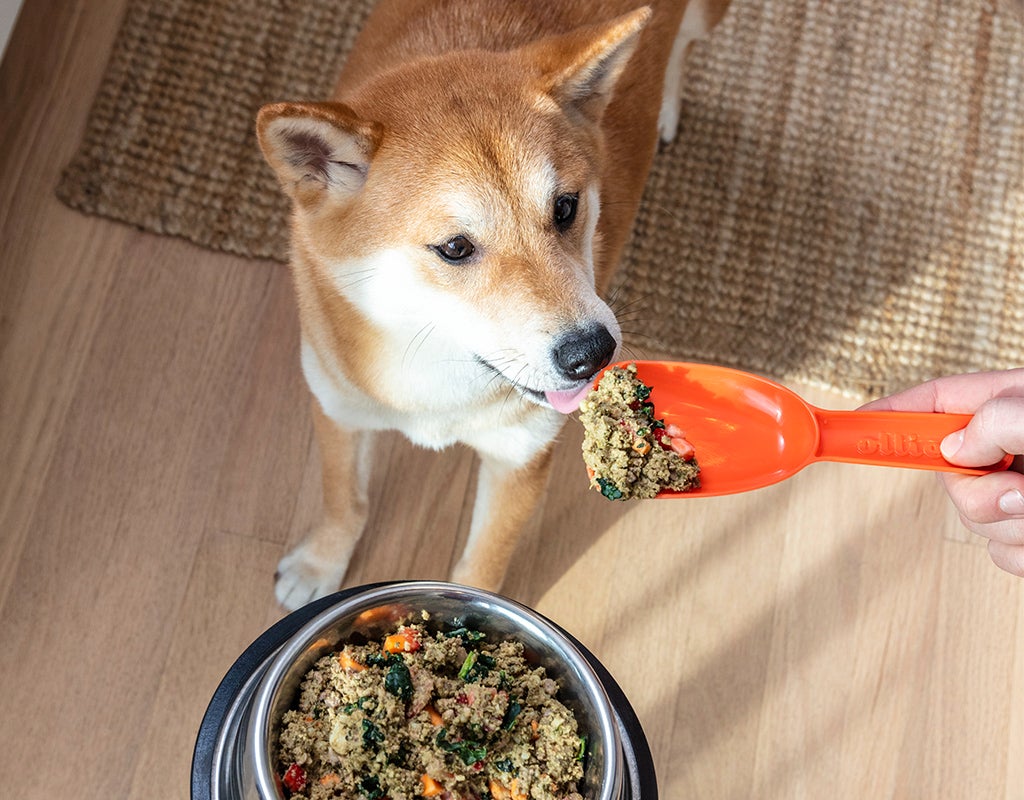Paid Advertisement
When it comes to feeding your dog, owners have plenty of options, from fresh dog food to canned food to raw food diets.
Let’s talk kibble. It’s easy and often inexpensive and, until now, your dog was perfectly happy eating it. Suddenly, though, your dog turns its nose up when you put the bowl down and it may not be clear why this happens. Luckily, dog owners have choices. Kibble, for all its convenience, isn’t the only option for a dog’s main diet.
Before you make any drastic changes to your dog’s diet, consult your veterinarian. If your dog has suddenly stopped eating something they’ve always eaten before, there may be intestinal or dental issues at play. If you determine that your pooch is just being picky, there are plenty of other dog feeding options on the market.
Add a Homemade Topping to Your Dog’s Kibble
There are some simple homemade choices that you can add to your dog’s kibble that may make it more palatable and even healthier. Cut up or puree fruits or vegetables, like carrots, green beans, and apples. Unsweetened canned pumpkin has fiber and may settle an upset stomach. Or try bone broth, which is thought to be good for the immune system.
Some owners may even opt for homemade dog food. However, such diets should only be prepared with advice from a veterinarian and a board-certified veterinary nutritionist to ensure proper safety and nutrition standards.
A fully cooked egg added to kibble is a good source of protein and, as a bonus, many dogs love eggs. However, some dogs may have food sensitivities to eggs, so avoid them if that’s the case with your pet. If your dog isn’t lactose-intolerant, plain yogurt, especially those with lots of active bacteria, is good for a dog’s digestive system. Any of these foods mixed in with kibble may entice your dog back to their food bowl.
One downside of adding food toppings is that your dog may decide they won’t eat plain kibble anymore. Therefore, you may have to be prepared to make topping kibble a long-term commitment.
Try Canned Dog Food
As with any other dog food, there’s a range of quality in canned food, from those that just barely meet nutritional standards to high-end well-balanced meals. Learning how to read the dog food label will help you choose. As a rule, high-quality canned food has more protein than kibble, contains fewer preservatives or artificial colorings, and has more moisture. On the other hand, it generally costs more than kibble, averaging anywhere from one to six dollars a day.
Ollie Pets, Inc.
Research Raw Food Diets
A raw food diet tries to replicate food a dog would have eaten in the wild. It consists of some mixture of meat, bones, organ meat, raw eggs, some fruits, vegetables, and dairy.
Fans of raw diets believe it’s the healthiest option for their dogs and that it promotes shinier coats, cleaner teeth, more energy, and healthier skin. Naysayers point out the risks, which include exposure to harmful bacteria for both dogs and humans, an unbalanced diet, and the potential dangers of sharp pieces of bone injuring a dog’s teeth and digestive tract.
In spite of its popularity, some research has come out against raw food diets. As early as 2012, the American Animal Hospital Association stated, “Based on overwhelming scientific evidence, AAHA does not advocate or endorse feeding pets any raw or dehydrated non-sterilized foods, including treats that are of animal origin.” The American Veterinary Medical Association discourages “the feeding to cats and dogs of any animal-source protein that has not first been subjected to a process to eliminate pathogens, because of the risk of illness to cats and dogs, as well as humans.”
Additionally, some frozen raw dog foods have been recalled due to the presence of pathogens like E. coli and salmonella. Owners feeding these diets should be careful to always stay aware of the most recent recall information for their brands.
If you’re considering a raw food diet, be sure to consult your vet first. Be careful to purchase from brands that adhere to high safety measures in their preparation and packaging. Lastly, consider the cost. Commercially prepared raw meats can range from $2.50 to $5.00 a day.
Ollie Pets, Inc.
Give Fresh Dog Food a Go
There’s a newer, increasingly popular addition to the array of dog food options: fresh dog food. For example, Ollie offers human-grade food, made with natural ingredients like chicken, beef, carrots, lamb, and blueberries. The recipes are devised by veterinary nutritionists, are cooked to retain maximum nutrients, and held to the highest safety standards. Then meals are packaged in insulated boxes and delivered directly to your door.
Research has shown that dogs need a balance of meat and vegetables. As important, a dog’s diet needs to suit their age, activity level, and general health. Rather than having to mix and match various types of food, Ollie has dog owners answer a few questions about their dog and then devises a customized meal plan, including the ingredients and amount of food your dog will receive in each meal.
There are many benefits to fresh food aside from convenience:
It’s made with ingredients you can trust. Fresh dog food labels won’t include seven-syllable chemical and filler names, just actual, real food, Fresh dog food is highly bioavailable. A word often used in terms of medication, bioavailability describes the rate and degree at which a substance (in the case of dog food, nutrients) can be accessed and used by the body. It’s good for the immune system. A diet rich in antioxidants and protein can boost a dog’s immunity response and eliminate or lessen the severity of disease and illness. Weight management is built-in. Portion control combined with a customized diet like the ones offered by Ollie eliminates the heavy starches and fillers that lead to weight gain. Owners report that dogs on a fresh food diet have healthier skin and coats, as well as fewer allergy symptoms.
Fresh food combines convenience with quality, nutrition, and safety. That does come with a price range of about two to twelve dollars a day, depending on your dog’s size and how many meals they consume per day. So that’s another factor to consider when deciding on dog food.
You’ve established that your dog is healthy and that there’s no medical reason for their aversion to kibble. Take heart! With so many options, ranging from canned and raw food to freshly prepared and packaged human-grade fresh dog food, you’re bound to find something that suits your dog’s taste as well as your preference and budget.








